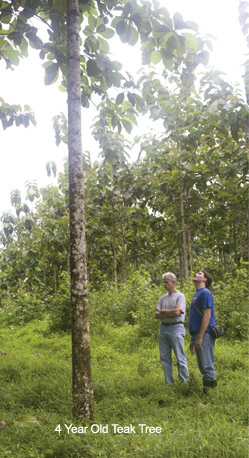


The trees will be planted in 3.5 by 3.5 meter grids. This spacing forces the trees to grow straight and tall as they compete for sunlight, increasing the marketable lumber per tree. As this competition increases, the weaker trees are thinned out to allow the healthier trees more room to grow. These thinnings typically occur around years 8, 12, and 16, but the precise timing will be determined by a forestry engineer in order to achieve the maximum possible growth rate. The final harvest takes place when the trees are 20 to 25 years old.
Teak trees are the heart of this opportunity. Teak is a very valuable species that originally comes from Southeast Asia. Teak stands up to the elements very well and is used in many exterior applications. It is common in yachts, patio chairs and tables, and high end furniture. In its native territory, many Buddhist and Hindu temples and shrines carved from teak hundreds of years ago stand as testaments to the virtues of teak.
Not every square meter of soil on our property will be appropriate for teak. After setting 15% of the land aside for conservation purposes, as required by certification programs, the rest of the land not suited to teak will be planted with species native to Costa Rica.
Some of the native species are much more valuable than teak, but are more difficult to grow in a plantation environment. Other species grow well in plantations, but there is not enough data to project growth rates or price trends. This diversification lessens the overall risk while providing an opportunity to grow other, potentially higher value species.
Please contact Bo Connelly with specific questions on plantation costs, growth rates, and projected lumber values.